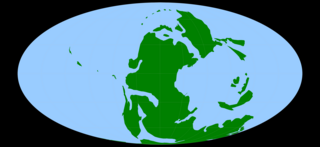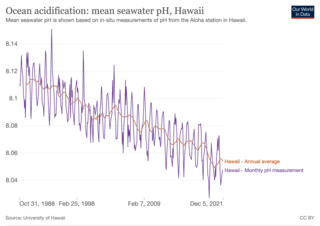
The Permian is a geologic period and stratigraphic system which spans 47 million years from the end of the Carboniferous Period 298.9 million years ago (Mya), to the beginning of the Triassic Period 251.902 Mya. It is the last period of the Paleozoic Era; the following Triassic Period belongs to the Mesozoic Era. The concept of the Permian was introduced in 1841 by geologist Sir Roderick Murchison, who named it after the region of Perm in Russia.

Approximately 251.9 million years ago, the Permian–Triassicextinction event forms the boundary between the Permian and Triassic geologic periods, and with them the Paleozoic and Mesozoic eras. It is the Earth's most severe known extinction event, with the extinction of 57% of biological families, 83% of genera, 81% of marine species and 70% of terrestrial vertebrate species. It is also the greatest known mass extinction of insects. It is the greatest of the "Big Five" mass extinctions of the Phanerozoic. There is evidence for one to three distinct pulses, or phases, of extinction.

The Triassic–Jurassic (Tr-J) extinction event (TJME), often called the end-Triassic extinction, was a Mesozoic extinction event that marks the boundary between the Triassic and Jurassic periods, 201.4 million years ago, and is one of the top five major extinction events of the Phanerozoic eon, profoundly affecting life on land and in the oceans. In the seas, the entire class of conodonts and 23–34% of marine genera disappeared. On land, all archosauromorphs other than crocodylomorphs, pterosaurs, and dinosaurs became extinct; some of the groups which died out were previously abundant, such as aetosaurs, phytosaurs, and rauisuchids. Some remaining non-mammalian therapsids and many of the large temnospondyl amphibians had become extinct prior to the Jurassic as well. However, there is still much uncertainty regarding a connection between the Tr-J boundary and terrestrial vertebrates, due to a lack of terrestrial fossils from the Rhaetian (latest) stage of the Triassic. What was left fairly untouched were plants, crocodylomorphs, dinosaurs, pterosaurs and mammals; this allowed the dinosaurs, pterosaurs, and crocodylomorphs to become the dominant land animals for the next 135 million years.

Panthalassa, also known as the Panthalassic Ocean or Panthalassan Ocean, was the vast superocean that encompassed planet Earth and surrounded the supercontinent Pangaea, the latest in a series of supercontinents in the history of Earth. During the Paleozoic–Mesozoic transition, the ocean occupied almost 70% of Earth's surface, with the supercontinent Pangaea taking up less than half. The original, ancient ocean floor has now completely disappeared because of the continuous subduction along the continental margins on its circumference. Panthalassa is also referred to as the Paleo-Pacific or Proto-Pacific because the Pacific Ocean is a direct continuation of Panthalassa.

A cold seep is an area of the ocean floor where seepage of fluids rich in hydrogen sulfide, methane, and other hydrocarbons occurs, often in the form of a brine pool. Cold does not mean that the temperature of the seepage is lower than that of the surrounding sea water; on the contrary, its temperature is often slightly higher. The "cold" is relative to the very warm conditions of a hydrothermal vent. Cold seeps constitute a biome supporting several endemic species.

The Late Ordovician mass extinction (LOME), sometimes known as the end-Ordovician mass extinction or the Ordovician-Silurian extinction, is the first of the "big five" major mass extinction events in Earth's history, occurring roughly 445 million years ago (Ma). It is often considered to be the second-largest known extinction event, in terms of the percentage of genera that became extinct. Extinction was global during this interval, eliminating 49–60% of marine genera and nearly 85% of marine species. Under most tabulations, only the Permian-Triassic mass extinction exceeds the Late Ordovician mass extinction in biodiversity loss. The extinction event abruptly affected all major taxonomic groups and caused the disappearance of one third of all brachiopod and bryozoan families, as well as numerous groups of conodonts, trilobites, echinoderms, corals, bivalves, and graptolites. Despite its taxonomic severity, the Late Ordovician mass extinction did not produce major changes to ecosystem structures compared to other mass extinctions, nor did it lead to any particular morphological innovations. Diversity gradually recovered to pre-extinction levels over the first 5 million years of the Silurian period.
The Guadalupian is the second and middle series/epoch of the Permian. The Guadalupian was preceded by the Cisuralian and followed by the Lopingian. It is named after the Guadalupe Mountains of New Mexico and Texas, and dates between 272.95 ± 0.5 – 259.1 ± 0.4 Mya. The series saw the rise of the therapsids, a minor extinction event called Olson's Extinction and a significant mass extinction called the end-Capitanian extinction event. The Guadalupian was previously known as the Middle Permian.

Ocean acidification is the ongoing decrease in the pH of the Earth's ocean. Between 1950 and 2020, the average pH of the ocean surface fell from approximately 8.15 to 8.05. Carbon dioxide emissions from human activities are the primary cause of ocean acidification, with atmospheric carbon dioxide levels exceeding 410 ppm. CO2 from the atmosphere is absorbed by the oceans. This chemical reaction produces carbonic acid which dissociates into a bicarbonate ion and a hydrogen ion. The presence of free hydrogen ions lowers the pH of the ocean, increasing acidity. Marine calcifying organisms, such as mollusks and corals, are especially vulnerable because they rely on calcium carbonate to build shells and skeletons.
In the geologic timescale, the Capitanian is an age or stage of the Permian. It is also the uppermost or latest of three subdivisions of the Guadalupian Epoch or Series. The Capitanian lasted between 264.28 and 259.51 million years ago. It was preceded by the Wordian and followed by the Wuchiapingian.

The Early Triassic is the first of three epochs of the Triassic Period of the geologic timescale. It spans the time between 251.9 Ma and 247.2 Ma. Rocks from this epoch are collectively known as the Lower Triassic Series, which is a unit in chronostratigraphy. The Early Triassic is the oldest epoch of the Mesozoic Era. It is preceded by the Lopingian Epoch and followed by the Middle Triassic Epoch. The Early Triassic is divided into the Induan and Olenekian ages. The Induan is subdivided into the Griesbachian and Dienerian subages and the Olenekian is subdivided into the Smithian and Spathian subages.

The Pteriida are an order of large and medium-sized marine bivalve mollusks. It includes five families, among them the Pteriidae.

Hindeodus is an extinct genus of conodonts in the family Anchignathodontidae. The generic name Hindeodus is a tribute to George Jennings Hinde, a British geologist and paleontologist from the 1800s and early 1900s. The suffix -odus typically describes the animal's teeth, essentially making Hindeodus mean Hinde-teeth.
Background extinction rate, also known as the normal extinction rate, refers to the standard rate of extinction in Earth's geological and biological history before humans became a primary contributor to extinctions. This is primarily the pre-human extinction rates during periods in between major extinction events. Currently there have been five mass extinctions that have happened since the beginning of time all resulting from a variety of reasons.
The Emeishan Traps constitute a flood basalt volcanic province, or large igneous province, in south-western China, centred in Sichuan province. It is sometimes referred to as the Permian Emeishan Large Igneous Province or Emeishan Flood Basalts. Like other volcanic provinces or "traps", the Emeishan Traps are multiple layers of igneous rock laid down by large mantle plume volcanic eruptions. The Emeishan Traps eruptions were serious enough to have global ecological and paleontological impact.

The origin of the brachiopods is uncertain; they either arose from reduction of a multi-plated tubular organism, or from the folding of a slug-like organism with a protective shell on either end. Since their Cambrian origin, the phylum rose to a Palaeozoic dominance, but dwindled during the Mesozoic.

Criocephalosaurus is an extinct genus of tapinocephalian therapsids that lived in Southern Africa during the Guadalupian epoch of the Permian. They are the latest surviving dinocephalians, extending past the Abrahamskraal Formation into the lowermost Poortjie Member of the Teekloof Formation in South Africa. They are also regarded as the most derived of the dinocephalians, alongside Tapinocephalus, and the most abundant in the fossil record.

Shell growth in estuaries is an aspect of marine biology that has attracted a number of scientific research studies. Many groups of marine organisms produce calcified exoskeletons, commonly known as shells, hard calcium carbonate structures which the organisms rely on for various specialized structural and defensive purposes. The rate at which these shells form is greatly influenced by physical and chemical characteristics of the water in which these organisms live. Estuaries are dynamic habitats which expose their inhabitants to a wide array of rapidly changing physical conditions, exaggerating the differences in physical and chemical properties of the water.

The Capitanian mass extinction event, also known as the end-Guadalupian extinction event, the Guadalupian-Lopingian boundary mass extinction, the pre-Lopingian crisis, or the Middle Permian extinction, was an extinction event that predated the end-Permian extinction event. The mass extinction occurred during a period of decreased species richness and increased extinction rates near the end of the Middle Permian, also known as the Guadalupian epoch. It is often called the end-Guadalupian extinction event because of its initial recognition between the Guadalupian and Lopingian series; however, more refined stratigraphic study suggests that extinction peaks in many taxonomic groups occurred within the Guadalupian, in the latter half of the Capitanian age. The extinction event has been argued to have begun around 262 million years ago with the Late Guadalupian crisis, though its most intense pulse occurred 259 million years ago in what is known as the Guadalupian-Lopingian boundary event.

Marine biogenic calcification is the production of calcium carbonate by organisms in the global ocean.

The Arctic ocean covers an area of 14,056,000 square kilometers, and supports a diverse and important socioeconomic food web of organisms, despite its average water temperature being 32 degrees Fahrenheit. Over the last three decades, the Arctic Ocean has experienced drastic changes due to climate change. One of the changes is in the acidity levels of the ocean, which have been consistently increasing at twice the rate of the Pacific and Atlantic oceans. Arctic Ocean acidification is a result of feedback from climate system mechanisms, and is having negative impacts on Arctic Ocean ecosystems and the organisms that live within them.














